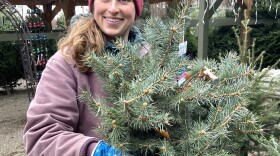Growing hydrangeas, Hydrangea macrophylla, in New Hampshire can be a challenge, but it can also be rewarding, provided you have the right expectations and you're choosing the right species to grow.
"There are six species of hydrangea that can be grown in New Hampshire, and they all have very different maintenance needs and site requirements,” says Emma Erler, lead horticulturist at Kirkwood Gardens at Squam Lakes Natural Science Center, and host of Homegrown NH.
“The blue mophead type of big leaf hydrangeas are the most difficult to grow in our state,” Erler says. The color blue is rarely seen naturally in the garden, so blue flowers are highly sought-after.
“They like a nice, mild climate. They form their buds on old wood, meaning they formed their flower buds in the prior season, and those flower buds have to survive a winter.”
Our New Hampshire winters can be harsh, and many times those over-wintering flower buds are killed. In addition to freezing temperatures, snow and ice can overload and break branches, and the dry, cold wind can be problematic for buds as well.
Pruning at the wrong time is also an issue with mopheads. If you prune your hydrangeas in the fall, you've probably pruned away next year's flower buds. If you prune early in the Spring, you might also trim away the buds. They are best pruned in mid- to late May, once new growth begins to emerge from stems or the bases of plants.
Erler suggests trying reblooming varieties of mophead hydrangeas, and fortunately, many of these are coming on to the market. Make sure the label says that it is reblooming, which means it will bloom on new growth as well as old growth.
The showy parts of hydrangeas are not functional flowers at all! The colorful petals are actually sepals, modified leaves that surround true flowers in the center.
Mopheads may not have any fertile flowers at all, so will not produce any pollen or nectar, and with the many sepals are difficult for pollinators to get to.

If you want to move on to other species of hydrangea, there are a few you can try. “One of my favorites is the smooth hydrangea. Some people call these Annabelle hydrangeas. These are typically white, sometimes pink, sometimes green. These are hardy to USDA gardening Zone 3, so you ca grow them throughout New Hampshire,” says Erler.
“The key is that they bloom on new growth; the flower buds are formed in the spring and the plant blooms in the summer, so you're pretty much guaranteed blooms,” she says.
The smooth hydrangea, Hydrangea arborescens, is native to the southeastern United States, so while you won't find it growing in New Hampshire in the wild, you don't have to go too far south to find it.
Erler says the flatter, lacecap-type flowers of the smooth hydrangea are more pollinator-friendly than mophead hydrangeas. “They tend to attract a lot of insects in the gardens at Kirkwood. I see bees all over that plant.”
The same goes for panicle hydrangeas, Hydrangea paniculata, which are more of a tree-type hydrangea. “They are much more cold-tolerant and bloom on new growth. They are pretty problem-free and actually don't mind drought, which is something most hydrangeas don't tolerate.”
If you're looking to replace your hydrangea or to choose a different plant, Erler has some flowering alternatives that are native to this area. “I personally love witch hazels. They get a lot bigger than a hydrangeas, but they have a lovely fall bloom, and they're used by a lot of different beneficial insects.”
She also recommends a number of different viburnums. “Viburnums have a flat top flower that's similar to a lacecap-type hydrangea, used by a lot of different insects, and you're pretty much guaranteed a bloom.”
The remaining types of hydrangeas which can be grown in New Hampshire include the oakleaf hydrangea (Hydrangea quercifolia) which features have distinctive oakleaf-shaped leaves. Mountain hydrangea (Hydrangea serrata) is more compact than the bigleaf type and cold-tolerant, and climbing hydrangea (Hydrangea anomala subsp. petiolaris) is a vining species.
See you in the garden!
Homegrown NH is a collaboration between Squam Lakes Natural Science Center and NHPR.











